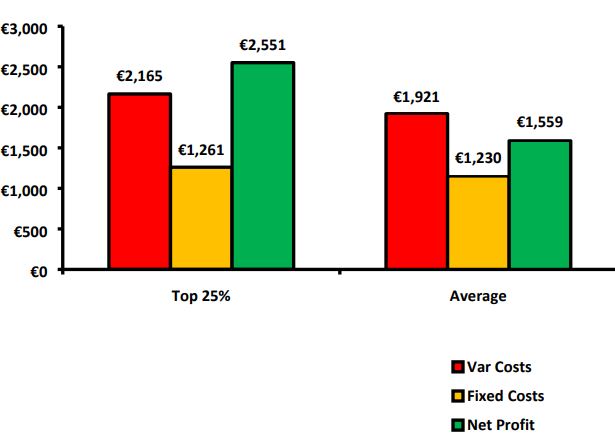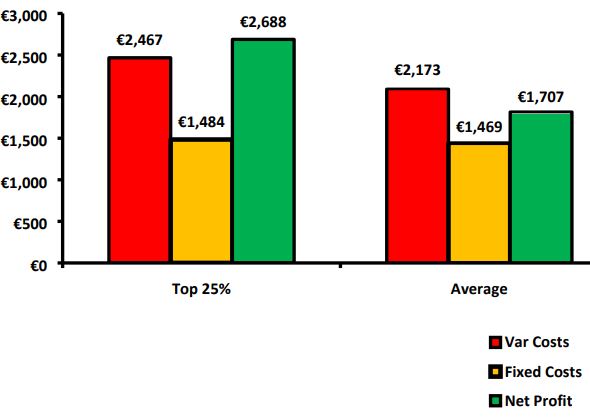The top 25% of spring-calving dairy farmers are making €992/ha and €300/cow more than the average, according to the Teagasc 2018 profit monitor analysis on spring-calving farms.
This top-line figure represents a 39% increase on the average levels of performance across the 1,390 spring-calving dairy farms recorded.
These higher profit spring milk producers were: larger scale (10% larger herds); more intensively stocked (14% higher stocking rate); and consumed 1.6t DM/ha more grass (19% more) – in what was for many a very dry summer.
In terms of output, the top 25% of farms produced 244kg of MS/ha, or 24% more than the average farm (1,031kg/ha). This is as a result of a higher stocking rate (+0.32LU/ha) and higher output per livestock unit (LU) (+38kg of MS/cow).
Leading to the top 25% achieving a gross output of €1,266/ha more than the average spring milk producer as a result.
Looking at the costs of production, the top spring-calving dairy farms had lower variable costs per cow, by €12/cow, but higher variable costs per hectare, by €244/ha – due to the higher stocking rate. In addition, meal costs were slightly higher than the average by €16/cow.
Meanwhile, the fixed costs for the top herds were €56/cow lower but €30/ha higher, when compared to the average.
Where winter milk is concerned, the top 25% of farms generated a net profit of €2,688/ha in 2018 compared to €1,707/ha on the average farms. This represents a difference of 36%.
In contrast to their spring milk counterparts, the high profit winter milk producers were, similar in scale (2% smaller herds) but more intensively stocked (12% higher stocking rate) and consumed 1.1t DM/ha more grass (13% greater).
In terms of output, the top 25% of farms produced 228kg of MS/ha, or 20% higher than on the average farm (1,124kg/ha). This is as a result of a higher stocking rate (+0.27LU/ha) and higher output per LU (+37kg of MS/cow).
Subsequently, this lead to the top 25% achieving a gross output of €1,288/ha more than the average spring milk producer.
The top winter milk producers had higher variable costs per cow and per hectare of €14/cow and €294/ha respectively. Additionally, meal costs were slightly higher than the average by €32/cow on the top farms.
Finally, the fixed costs for the top herds were €63/cow lower but €15/ha higher.
According to Teagasc’s Tom O’Dwyer, this profit monitor analysis can provide farmers with useful targets or benchmarks for comparison. These comparisons can then raise questions and find areas of weakness.
Farmers can then formulate a plan to tackle the underlying issues, set a forward budget and monitor cash-flow throughout the year.
If you are already matching the performance of the top 25% of farmers, Tom says the challenge then becomes maintaining that level of performance and avoiding ‘system creep’ over time.




